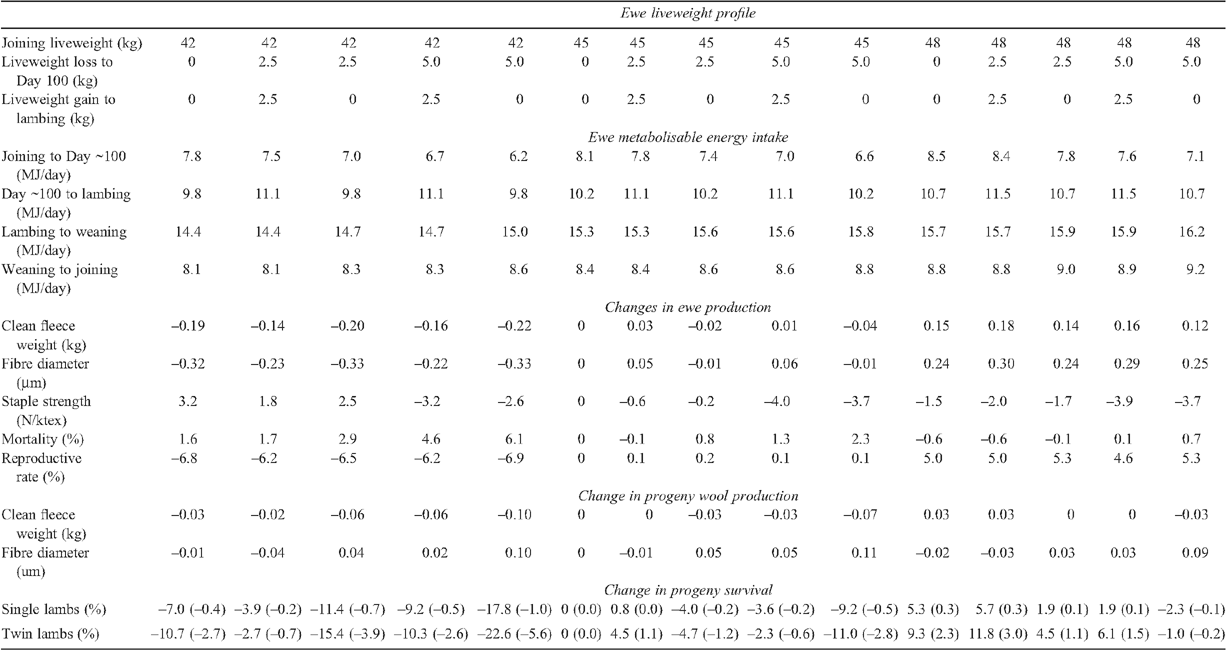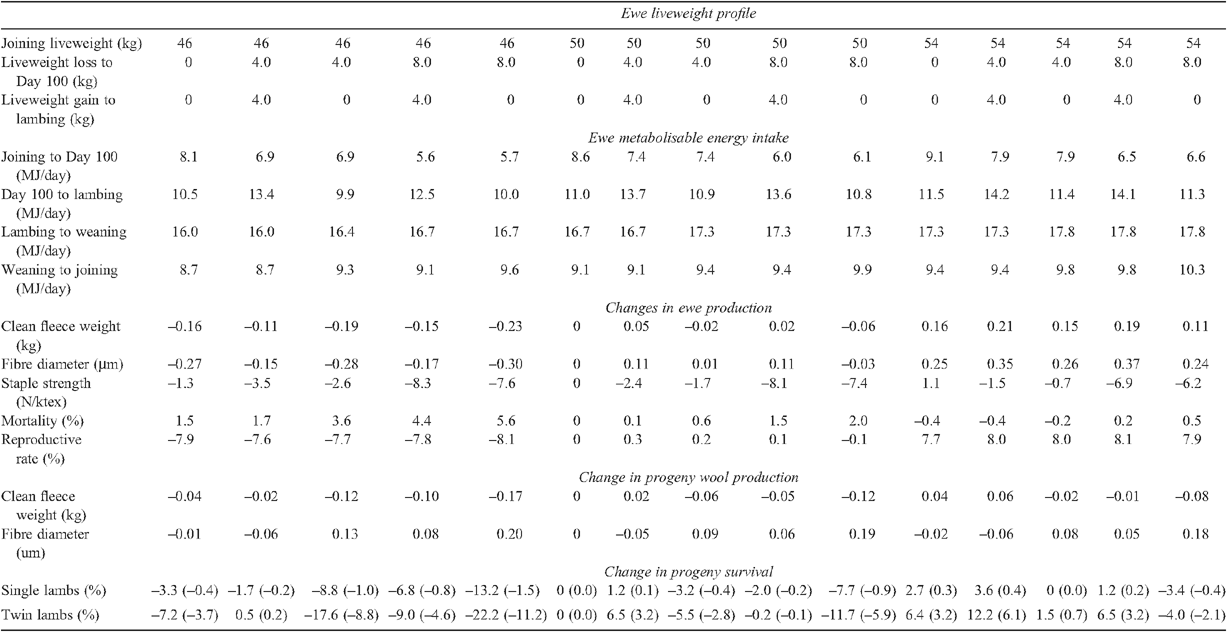Whole-farm profit and the optimum maternal liveweight profile of Merino ewe flocks lambing in winter and spring are influenced by the effects of ewe nutrition on the progeny’s survival and lifetime wool production
J. M. Young A , A. N. Thompson B D E F , M. Curnow C and C. M. Oldham CA Farming Systems Analysis Service, RMB 309, Kojonup, WA 6395, Australia.
B Department of Primary Industries Victoria, Private Bag 105, Hamilton, Vic. 3300, Australia.
C Department of Agriculture and Food Western Australia, 444 Albany Highway, Albany, WA 6330, Australia.
D Present address: Department of Agriculture and Food Western Australia, 3 Baron-Hay Court, South Perth, WA 6151, Australia.
E Present address: School of Veterinary and Biomedical Sciences, Murdoch University, 90 South Street, Murdoch, WA 6150, Australia.
F Corresponding author. Email: andrew.thompson@agric.wa.gov.au
Animal Production Science 51(9) 821-833 https://doi.org/10.1071/AN10078
Submitted: 19 May 2010 Accepted: 12 July 2011 Published: 14 September 2011
Journal Compilation © CSIRO Publishing 2011 Open Access CC BY-NC-ND
Abstract
Profitability of sheep production systems in southern Australia is optimised at a stocking rate that provides adequate nutrition for breeding ewes and enables efficient utilisation of grown pasture and supplements. In this paper we used bio-economic modelling to develop optimum liveweight1 profiles for spring-lambing Merino ewes in different environments. The modelling included the impacts of the ewe liveweight profile on the production of the ewe and the survival and lifetime wool production of her progeny. Fifteen ewe liveweight profiles were analysed for each region to determine the profitability of varying ewe liveweight at joining, varying rate of loss of liveweight after joining and the rate of gain in liveweight from the minimum to lambing. The analyses support the hypotheses that whole-farm profitability is sensitive to the liveweight profile of Merino ewe flocks and that there is a liveweight profile that maximises whole-farm profit. The variation between the most and least profitable ewe liveweight profile was $69 0002 per farm ($14.30/ewe) for south-west Victoria, $51 000 per farm ($8.70/ewe) for Great Southern Western Australia and $33 300 per farm ($9.70/ewe) for southern New South Wales. The changes in profit were due to differences in costs of feeding to achieve the ewe liveweight profile and its influence on the production of both the ewes and their progeny. Failure to include the impacts of liveweight profile on progeny survival and lifetime wool production incorrectly identifies the optimum ewe liveweight profile and provided inaccurate estimates of profitability. The optimum liveweight profiles for ewes lambing in spring were similar for all three regions and insensitive to changing commodity prices, pasture productivity and management. The optimum profile was to join ewes at ~90% of the standard reference weight of the genotype, lose a small amount of weight after joining and regain weight in late pregnancy to return to the joining weight by lambing. Regaining the liveweight lost in early pregnancy by lambing is the most important target to achieve. The cost per farm of missing this liveweight target by 1 kg was $13 000 ($2.60/ewe) for south-west Victoria, $8900 ($1.45/ewe) for Great Southern Western Australia and $5500 ($1.65/ewe) for southern New South Wales. By contrast, the cost per farm of missing the joining target by 1 kg was $5500 for south-west Victoria and less than $2000 across the other two regions. Whole-farm profit increased with increasing stocking rate up to an optimum and regardless of stocking rate there is an additional opportunity to increase whole-farm profit by up to 15% by managing ewes to achieve the optimum liveweight profile. This indicates that the optimum liveweight profile should be achieved by increasing the level of grain feeding and altering the timing of utilising the farm feed resources rather than manipulating stocking rate.
Introduction
Profitability of sheep production systems in southern Australia is optimised at a stocking rate that provides adequate nutrition for breeding ewes and enables efficient utilisation of grown pasture and supplements (Warn et al. 2006; Young et al. 2011). These systems are characterised by large fluctuations in the quantity and quality of pasture available between and within years (Rossiter 1966; Purser and Southey 1984; Thompson et al. 1994). Therefore, achieving the appropriate balance between stocking rate, ewe production and levels of supplementary feeding is a major challenge for these systems.
To optimise stocking rate of ewes requires an understanding of the full range of impacts of manipulating nutrition on the performance of the ewe and her progeny. An analysis by Thompson and Young (2002), which included an estimate of these effects, indicated that altering ewe nutrition during pregnancy could have large effects on farm profitability. However, this work only considered extreme nutritional regimes and did not attempt to identify an optimal liveweight profile. The Lifetimewool project has shown that the liveweight profile of Merino ewes can reliably predict the production of ewes (Ferguson et al. 2011) and their progeny (Oldham et al. 2011; Thompson et al. 2011a). This new information provides the necessary production responses required to develop optimum liveweight profiles for ewe flocks in different regions and lambing at different times.
Identifying the optimum liveweight profile requires valuing the trade-off between the extra production achieved and the cost of the feed required to achieve the profile. The feed can be provided by altering stocking rate, timing of grazing (deferment) or the amount of supplement fed. This complexity and the large number of potential combinations of options can only be effectively handled by modelling. MIDAS (Model of an Integrated Dryland Agricultural System), a whole-farm profit maximisation model (Kingwell and Pannell 1987), was an appropriate model for this analysis because it includes the options and the trade-offs in the context of a whole-farm feed budget. In this paper we test the hypotheses that whole-farm profitability is sensitive to the liveweight profile of Merino ewe flocks and there is a liveweight profile that will maximise whole-farm profit. We further reasoned that whole-farm profit and the optimum liveweight profile are altered by the inclusion of the impacts on the progeny.
Materials and methods
This analysis was carried out for three regions of southern Australia with Merino ewes lambing in spring;
-
South-west Victoria (Vic.): this zone is characterised by an 8-month growing season and winter rainfall (>550 mm) with a mix of annual and perennial ryegrasses and subterranean clover and a total pasture production of 7–8 t of DM/ha.
-
Great Southern region in Western Australia (Great Southern WA): this zone is characterised by winter rainfall (400–550 mm) and a 6-month growing season with a mix of annual grasses and subterranean clover and a total pasture production of 6–8 t DM/ha.
-
Southern New South Wales (NSW): this zone is characterised by a 6-month growing season and winter rainfall (450–600 mm) with a mix of annual grasses, phalaris and subterranean clover and a total pasture production of 6–8 t DM/ha.
For each environment the profitability of altering the nutrition profile of the ewe flock was examined using a mathematical programming model. This is a modelling framework that maximises an objective function by determining the best mix of activities with the constraint of a limited set of resources; a more detailed description of mathematical programming is provided by Pannell (1996). A large number of production options and resource constraints confronting farmers can be included. This capacity enables the whole farming system to be represented, including the interrelatedness of production enterprises, such as livestock grazing feed from different sources at different times of the year. It ensures that all calculations of profitability of different nutrition profiles were done at the optimum stocking rate and with the least cost way of achieving the nutrition profile.
Identifying the least cost nutrition strategy is a non-trivial issue because there are many methods to alter the liveweight profile of reproducing ewes. The options include altering grain feeding, stocking rate, timing of grazing of different feed sources across the farm and the allocation of feed between reproducing and dry animals. A comparison of the profitability of nutritional profiles calculated without identifying the minimum cost feeding strategy could draw an incorrect conclusion about the desirability of a particular nutrition profile.
Existing MIDAS models for south-west Vic. and Great Southern WA (Young 1995) were used in this analysis. The analysis for southern NSW required a new model based on crop and pasture production data for that region (Phil Graham, pers. comm.). The versions of MIDAS used varied in the number of land management units and the cropping and pasture options (Table 1) and in the growth rate and quality of pastures available throughout the year.
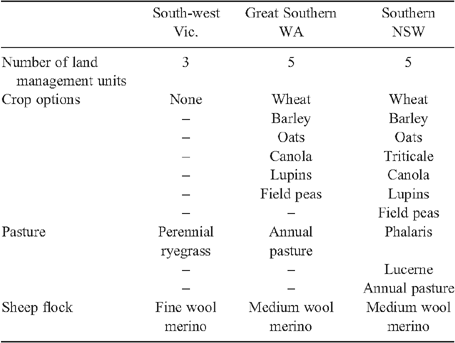
|
A self-replacing Merino flock with reproducing ewes and associated non-reproducing stock was described in the model. Fifteen liveweight profiles for the reproducing ewes were analysed with one liveweight profile evaluated at a time. The ewe liveweights were adjusted for conceptus weight and weight of greasy wool. The non-reproducing stock were weaners, hoggets and wethers and for each of these classes of stock the model chose the best of four different liveweight profiles. These four profiles varied in the amount of liveweight gain in early summer, the amount of liveweight loss around the break of season, the delay to commencement of weight gain after the break of season and the average liveweight for the whole year. Each liveweight profile required a different feeding strategy for the non-reproducing stock and resulted in a different level of production.
The feed budget in the model is based on dividing the year into 10 periods. The periods are shorter at pasture senescence and the break of season and longer in the middle of the growing season and mid summer (Table 2). For each period, the energy requirement and the intake capacity for each liveweight profile of each livestock class is calculated based on liveweight and liveweight change (Standing Committee on Agriculture 1990). The feed requirement of the animals can be met from pasture, crop residues or grain feeding with the constraint that the quantity of feed consumed is less than or equal to the intake capacity. Feed that is available on the farm that is not required to meet the energy demands of the livestock on hand can be deferred and utilised in a later period, although the quantity and quality of the feed may decline. This assumption implies that the farm manager is able to actively manage the grazing of the stock and allocate feed to different stock classes based on their priority. This contrasts with simulation models that typically allocate the feed to animals up to the level where the intake capacity of the animals is fulfilled.
At the beginning of the growing season pasture density was affected by paddock history or rotation; the longer duration since cropping the greater the density. During the periods of the growing season, pasture growth was input as a function of the quantity of feed on offer at the beginning of the period. The growth function varied with the land management unit and the period during the year. The structure of the mathematical programming algorithm required that the asymptotic growth function was represented as a linearised convex relationship as graphically presented in Fig. 1. This structure allows the mathematical programming optimisation algorithm to vary grazing intensity in each period, which alters feed on offer, which then affects subsequent pasture growth rate. Therefore, in each run of the model the pasture growth rate could vary based on grazing intensity, area of pasture on each land management unit and rotation. Typical levels of pasture growth and digestibility are shown in Table 3.
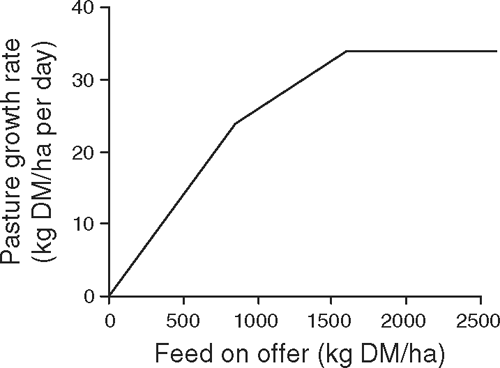
|
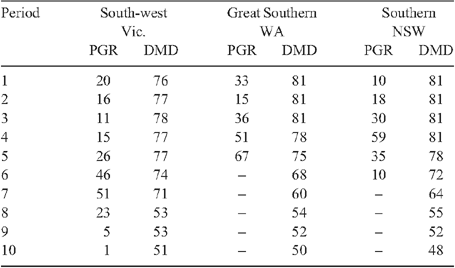
|
In the version of the model which ignores the link between ewe nutrition profile and progeny production, wool growth is a linear function of metabolisable energy intake based on White et al. (1979). The efficiency of growth (g/MJ of metabolisable energy) is calibrated to achieve the desired annual production level. Fibre diameter in each period is calculated from the wool growth rate assuming that length growth rate is proportional to cross-sectional area of the fibre and that the density of the fibre is constant. The reproductive rate achieved by the ewes is a function of liveweight at joining. For mature ewes the relationship is a 2 percentage points increase in number of lambs in utero for a 1-kg increase in liveweight at joining (Ferguson et al. 2011; R. Behrendt, unpubl. data). Survival of single- and twin-born lambs is independent of the ewe liveweight profile.
In the south-west Vic. model the production system is a traditional fine wool genotype with lambing in August–September and shearing in March. Surplus ewes are sold off shears in March and wethers are sold at 3 years old after shearing in September. In Great Southern WA and southern NSW a medium wool genotype is used with lambing in July–August and shearing in January. Surplus ewes and all wethers are sold as hoggets off shears at 1.5 years old. As an example of the productivity of each genotype the production of the ewes following a typical nutrition profile from joining through to lambing are outlined in Table 4. The typical profile involves losing 6–8 kg from joining to mid pregnancy and then maintaining maternal liveweight from mid pregnancy to lambing.

|
Fifteen different liveweight profiles were evaluated in this analysis. The profiles examined vary in the average liveweight of the ewes at joining, the average amount of weight lost to the minimum and then the amount of weight regained from the minimum to lambing (Figs 2–4). For each region there are three options for liveweight at joining, three rates of weight loss to the minimum and two rates of weight gain to lambing. The amount of weight gain or loss varies with region; however, the selection of the 15 patterns allows comparison of the effects on profitability of varying liveweight at joining, varying rate of loss of liveweight after joining and the rate of gain in liveweight before lambing. Each nutrition strategy examined has a similar pattern that varies in one of the above factors. This pairing of patterns allows calculation of the cost or benefit of varying the liveweight targets of ewes at different times of the reproductive cycle.
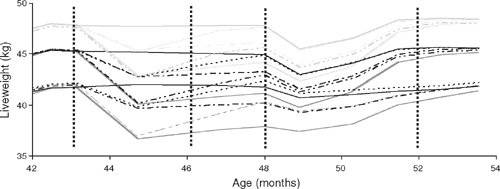
|
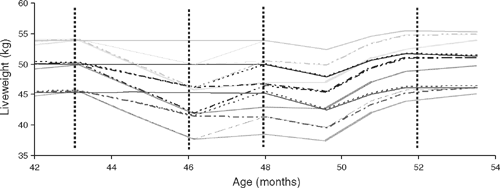
|
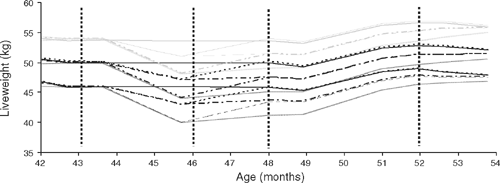
|
In the version of the model, which includes the link between the ewe nutrition profile and lamb survival and progeny wool production, the adjustments were calculated using the coefficients derived from the statistical analysis of the Vic. site reported by Oldham et al. (2011) and Thompson et al. (2011a), see Table 5. The calculation for the variation in survival had a further adjustment applied because the impact of ewe nutrition on progeny survival was greater in the paddock-scale experiments than the plot-scale experiments (Behrendt et al. 2011). The paddock-scale results were considered to be more appropriate than the plot-scale results because of the larger numbers of animals involved, a broader range of lambing environments and less frequent management interventions at lambing. The adjustments were determined by comparing the difference in survival in the plot-scale experiment with the paddock-scale experiments when the maternal liveweight profile was altered. The adjustment factors for Great Southern WA and southern NSW were 8.5 for singles and 2.0 for twins, whereas these adjustment factors were double these values for south-west Vic. The impacts of the adjustments are shown in Tables 6–8.
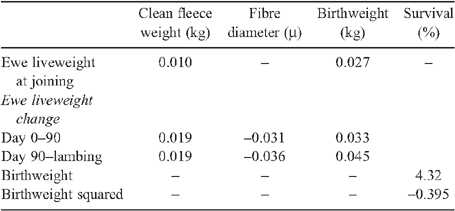
|
The adjustment in progeny wool production was based on hogget data and applied to all age groups of progeny because the weight of evidence supports that the progeny effects are permanent (Kelly et al. 1996, 2006; Thompson et al. 2011a). The production of the ewe component of the flock was also adjusted, because those animals are the progeny of the ewes from the previous generation, and it is assumed that the nutrition strategy for the ewes has been applied and the flock has achieved a steady state.
For each profile, the energy demands, the variation in production of the ewes and the variation in the production levels of the progeny calculated using the relationships described are detailed in Tables 6–8. A brief overview of the important detail in those Tables follows. Losing liveweight after joining reduces the energy requirement during that period but increases it in a later period depending on when the liveweight is regained, either before lambing or from lambing to next joining. Starting and finishing at a lower (or higher) liveweight affects ewe wool production, number of lambs conceived, progeny wool production and progeny survival. Fleece weight and fibre diameter of the ewe is closely correlated with energy intake so nutritional targets that require more energy produce more wool that is broader. The number of lambs conceived is proportional to the liveweight of the ewe at joining and so higher targets increase the conception and lambing rate.
Progeny fleece weight, birthweight and survival are closely related to liveweight of the ewes at lambing; the higher the liveweight, the higher the fleece weight, birthweight and survival. However, progeny fibre diameter is only related to change in ewe liveweight from joining to lambing, with loss of liveweight during this period increasing the fibre diameter. There is a small amount of variation in each of the progeny measures depending on whether liveweight was lost and then regained from joining to lambing or maintained throughout.
Results
Effects of nutrition profile on farm profitability
Changing the liveweight profile of the ewes altered profitability for each of the regions examined. The variation between the most profitable pattern and the least profitable pattern was greatest for south-west Vic. ($14.30/ewe, $69/ha). The Great Southern region in WA ($8.70/ewe, $51/ha) and Southern NSW ($9.70/ewe, $37/ha) had similar variation in profit (Tables 9–11). The greater variation shown in the Vic. analysis occurs because in this region the lambing environment is more extreme and a more sensitive relationship between ewe liveweight profile and perinatal survival was included in this model (Behrendt et al. 2011). The lower value per ha in the NSW analysis reflects the higher proportion of crop in this region and the difference in profit per ha of pasture ($53) is similar to the value for Great Southern WA.

|
Changing the liveweight profile of the ewe also alters the value of production, the stocking rate and the amount of supplement fed. The range in value of production was $23, $24 and $21/ewe for Vic., WA and NSW; the range in stocking rate was 1.5, 0.3 and 1.2 dry sheep equivalent/winter-grazed ha and the range in supplement fed was 8.3, 19.9 and 12.4 kg/dry sheep equivalent.
Effects of stocking rate on farm profitability
Whole-farm profit increased with increasing stocking rate up to an optimum and regardless of stocking rate there is an additional opportunity to increase whole-farm profit by up to 15% by managing ewes to achieve the optimum liveweight profile (Fig. 5).
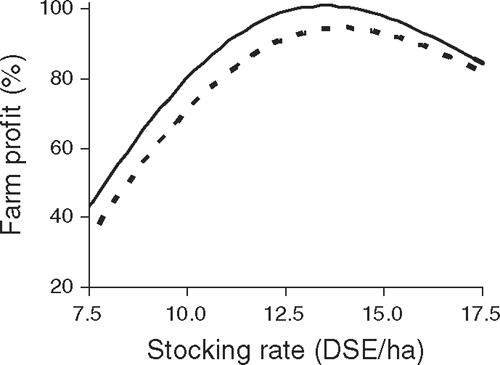
|
Optimum liveweight profiles
The most profitable of the 15 patterns examined for the south-west Vic. analysis was to join with a maternal liveweight of 42 kg, lose 2.5 kg to Day 100 and then regain the 2.5 kg to lamb at 42 kg (Table 9). The most profitable of the 15 patterns examined for Great Southern WA was to join at 46 kg, lose 4.0 kg to Day 100 and then regain the 4.0 kg to lamb at 46 kg (Table 10). The optimum profile for the southern NSW analysis was to join at 46 kg, lose 3.0 kg to Day 100 and then regain the 3.0 kg to lamb at 46 kg (Table 11). The optimum profile for each of the three regions for spring-lambing flocks follows a similar trend which is: join at the lowest weight, which was ~90% of the standard reference weight of the genotype, lose a small amount of weight to Day 100 and regain weight in late pregnancy to return to the joining weight by lambing.
The optimum profile was shown to be robust and the sensitivity analysis that tested 36 scenarios for the three regions showed only six scenarios in which the optimum profile varied from that identified for the standard production and prices (Table 12). In all six cases the optimum involved joining at a heavier liveweight and then losing a small amount of weight and then regaining the lost weight by lambing.
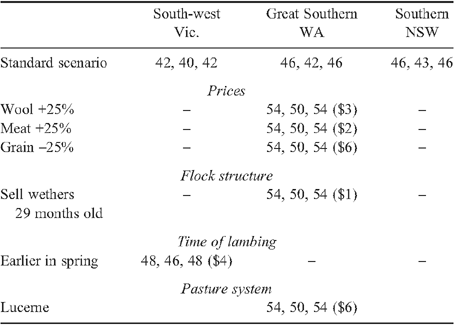
|
Effect on farm profitability of missing liveweight targets
The cost of missing a liveweight target by 1 kg varies from $0.20/ewe for the joining target in the Great Southern WA up to $2.60/ewe for the lambing target in south-west Vic. (Table 13). For all regions missing the lambing target has the highest penalty and this makes lambing the most important target for farmers to concentrate on. South-west Vic. has the highest cost for missing the lambing target and this is because of the greater impact of the ewe liveweight profile on perinatal survival in this environment.
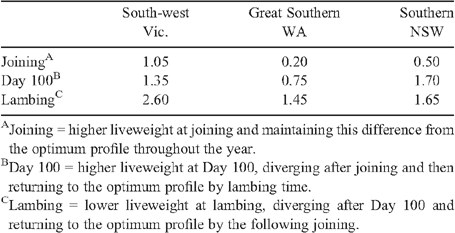
|
Importance of including progeny production effects when identifying optimum liveweight profiles
There was a considerable difference in the profitability of some patterns analysed when the effects of the liveweight profile of the ewes on the progeny survival and wool production were excluded from the analysis (Fig. 6). The linear regression fitted to the model output had an R2 of 0.21 indicating that the analysis carried out that excluded the progeny survival and progeny fleece production relationships gave erroneous results. In all three regions the liveweight profile identified as the optimum in the analysis that excluded the progeny relationships was different and involved greater loss of liveweight in early pregnancy and lower liveweight at lambing. The variation in profit for this analysis is caused by a combination of progeny survival and progeny wool production and the relative contribution of each varied with the region (Table 14). Survival is a larger contributor in south-west Vic., whereas wool production and the change in progeny fleece value is the greater driver in southern NSW and in Great Southern WA.
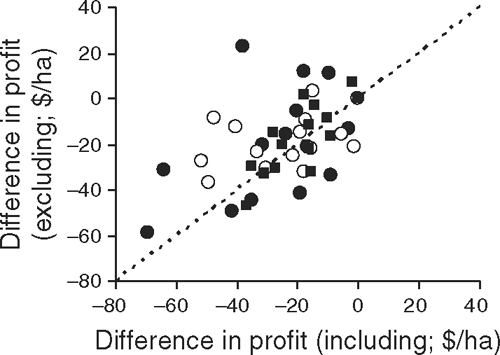
|

|
Discussion
Whole-farm profitability was sensitive to the liveweight profile of Merino ewe flocks lambing in spring and there was an optimum liveweight profile that maximised whole-farm profit (Tables 9–11). The analysis included profiles that varied in ewe liveweight at joining, mid pregnancy and lambing, and these profiles reflect commercial reality for three regions across southern Australia (Kelly 1992; Kleemann and Walker 2006). The variation between the most and least profitable ewe liveweight profile was $69 000 per farm for south-west Vic., $51 000 per farm for Great Southern WA and $33 300 per farm for southern NSW. The change in profit was due to differences in costs of feeding to achieve the ewe liveweight profile and its influence on the production of the ewes and their progeny. Therefore, we accept our hypotheses that whole-farm profitability is sensitive to the liveweight profile of Merino ewe flocks and there is a liveweight profile that will maximise whole-farm profit.
The optimum profiles for ewes lambing in spring were similar for all three regions. In all cases ewes were ~90% of the standard reference weight of the genotype at joining, lost ~3 kg during early pregnancy but by lambing had regained all the maternal liveweight that was lost earlier (Tables 9–11). The consistency of the shape of the optimum profile across the three regions, despite differing proportions of crop and variable impacts of weather on lamb survival, indicates the robustness of the result. This conclusion was reinforced by the sensitivity analysis which showed that the shape of the optimum profile was also insensitive to changing commodity prices, pasture productivity and management. While the shape of the profile was unchanged, in some scenarios a higher joining weight was indicated as optimal.
Farm profit and the subsequent shape of the optimum profile was dependent on including the production responses of the progeny. Failure to include the progeny effects reported by Oldham et al. (2011) and Thompson et al. (2011a) incorrectly identifies which profile is optimum and provides an inaccurate estimate of profitability (Fig. 6). The magnitude of this error in these analyses per farm was up to $61 000 for south-west Vic., $39 000 for Great Southern WA and $20 000 for southern NSW. Prior to this information being available, these impacts on the production and profitability of the flock were not considered in extension messages from consultants and advisers. This resulted in the recommendation of a management strategy which resulted in ewes losing more weight over pregnancy and not regaining the weight lost by lambing. Our hypothesis that whole-farm profit and the optimum ewe liveweight profile are altered by the inclusion of the impacts on perinatal survival and wool production of progeny was supported.
The effects of the ewe liveweight profile on farm profit were due to impacts on perinatal survival and wool production of progeny. When there is a stronger influence of ewe nutrition on progeny survival, such as occurs in south-west Vic. (Oldham et al. 2011), then survival has a greater contribution than fleece value (Table 14). The contribution of lamb survival to whole-farm profit was greater than that reported by Thompson and Young (2002). The relative contribution of survival to farm profit indicates that ewe nutrition will also be important in systems focussed on meat production. The component of the benefits due to progeny wool is constant regardless of changes to flock structure because in a self-replacing flock all animals are progeny of the previous generation, it is just the proportion that are ewes or wethers that changes. Weaning weight and post-weaning survival were also related to the ewe liveweight profile (Thompson et al. 2011b) but impacts on whole-farm profit were small (J. M. Young, unpubl. data). The importance of allocating the impacts between survival and wool production is to enable extrapolation of the results into regions and enterprises that have not been modelled.
Altering the shape of the profile by missing the liveweight targets for either joining, mid pregnancy or lambing can incur significant penalties depending on region (Table 13). Regaining the maternal liveweight lost in early pregnancy by lambing is the most important target to achieve. The cost per farm of missing this liveweight target by 1 kg was $13 000 for south-west Vic., $8900 for Great Southern WA and $5500 for southern NSW. By contrast, the cost per farm of missing the joining target by 1 kg was $5500 for south-west Vic. and less than $2000 across the other two regions. Our analysis consistently shows that the cost of extra feed to meet the liveweight target when joining on dry feed outweighs the value of production gains. For example, for southern NSW extra feeding to achieve a higher joining weight (50 versus 46 kg) and then allowing the same loss and gain of liveweight during pregnancy was $9/ha or $2.30/ewe less profitable (Table 11). Yet historically, liveweight at joining has been the focus for improving reproductive performance due to its effect on fertility and fecundity (Lindsay et al. 1975). As a general principle meeting the lambing target is more important than the joining target and it is only economic to gain liveweight to meet targets using green feed due to its low cost compared with grain supplements.
Whole-farm profit increased with increasing stocking rate up to an optimum and there are additional benefits of managing ewes to achieve the optimum liveweight profile. These effects of stocking rate on whole-farm profitability are consistent with other modelling (Warn et al. 2006) and farm benchmark data (Lean 2008). However, regardless of stocking rate there is an additional opportunity to increase whole-farm profit by up to 15% by managing ewes to the optimum liveweight profile. This indicates that the optimum liveweight profile should be achieved by increasing the level of grain feeding and altering the timing of utilising the farm feed resources rather than manipulating stocking rate. The grain feeding should be targeted at the period after joining to reduce the rate of loss of liveweight and at the period after the break of season to defer pasture to maximise the opportunity of meeting the liveweight at lambing using green feed. It is estimated that a 10–50% increase in the amount of supplement may be required to meet the optimum profile depending on the current management of the ewes. This increase in supplement fed to meet the profile is justified by a return on investment of ~100% for the regions modelled in our analysis.
MIDAS is a comparative static general equilibrium model and as such there are several implicit assumptions. Three important assumptions for the interpretation of the results of this analysis are; variation in seasonal conditions from year to year is not included, the ewe progeny when mature follow the same pattern of liveweight as their mothers, animals must return to their joining weight or slightly higher by next joining and the delay from feeding the ewes through till the income is received from the progeny is not costed. Nonetheless, using an average season to predict the most profitable approach to managing ewe nutrition the results can still be used to determine the most cost effective approach when seasons are not ‘normal’. Any savings in energy costs or extra costs incurred due to a poor season can be balanced against this contribution to make an assessment of the profitability of any liveweight profile for ewes. For example, if green feed is not available after Day 100 due to poor seasonal conditions and liveweight is not expected to be regained between Day 100 and lambing then the cost of not regaining the weight (from Table 13) can be compared with the cost of the supplement required to achieve the weight gain. At common grain prices it is more profitable to maintain the ewes from Day 100 rather than to feed extra supplement in an attempt to regain weight. In southern NSW there is a slight difference, in that meeting the lambing target is only slightly more important than losing condition from joining to Day 100. The most profitable solution then is to transfer more feed from early pregnancy to late pregnancy. Losing extra liveweight in early pregnancy and regaining some in late pregnancy is better than losing less and gaining less.
This analysis has determined the optimum nutritional profile for Merino ewes using liveweight and liveweight change. In order to present the recommendations and profile in a meaningful way to producers with a range of genotypes and frame sizes in their Merino flocks, the liveweight profiles were converted into condition scores using the conversion reported by van Burgel et al. (2011). The value of using condition scores is that it is an easy, quick and accurate method for producers to monitor the nutritional profile of ewes. The recommended condition score profiles for some regions were increased as additional welfare benefits could be achieved with minimal impact on profitability (<$0.60/ewe.kg). These recommended profiles have been widely used by extensionists and consultants (Curnow et al. 2011) and this reflects the rigour that was used in their development.
Acknowledgements
The Lifetimewool project was initiated as a cooperative project between the Department of Primary Industries Victoria and the Department of Agriculture and Food Western Australia. The project was funded by Australian woolgrowers through Australian Wool Innovation Limited and by five state departments of primary industries and agriculture.
References
Behrendt R, van Burgel AJ, Bailey A, Barber P, Curnow M, Gordon DJ, Hocking Edwards JE, Oldham CM, Thompson AN (2011) On-farm paddock-scale comparisons across southern Australia confirm that increasing the nutrition of Merino ewes improves their production and the lifetime performance of their progeny. Animal Production Science 51, 805–812.| On-farm paddock-scale comparisons across southern Australia confirm that increasing the nutrition of Merino ewes improves their production and the lifetime performance of their progeny.Crossref | GoogleScholarGoogle Scholar |
Curnow M, Oldham CM, Behrendt R, Gordon DJ, Hyder MW, Rose IJ, Whale JW, Young JM, Thompson AN (2011) Successful adoption of new guidelines for the nutritional management of ewes is dependent on the development of appropriate tools and information. Animal Production Science 51, 851–856.
| Successful adoption of new guidelines for the nutritional management of ewes is dependent on the development of appropriate tools and information.Crossref | GoogleScholarGoogle Scholar |
Ferguson MB, Thompson AN, Gordon DJ, Hyder MW, Kearney GA, Oldham CM, Paganoni BL (2011) The wool production and reproduction of Merino ewes can be predicted from changes in liveweight during pregnancy and lactation. Animal Production Science 51, 763–775.
| The wool production and reproduction of Merino ewes can be predicted from changes in liveweight during pregnancy and lactation.Crossref | GoogleScholarGoogle Scholar |
Kelly RW (1992) Lamb mortality and growth to weaning in commercial Merino flocks in Western Australia. Australian Journal of Agricultural Research 43, 1399–1416.
| Lamb mortality and growth to weaning in commercial Merino flocks in Western Australia.Crossref | GoogleScholarGoogle Scholar |
Kelly RW, MacLeod I, Hynd P, Greeff J (1996) Nutrition during fetal life alters annual wool production and quality in young Merino sheep. Australian Journal of Experimental Agriculture 36, 259–267.
| Nutrition during fetal life alters annual wool production and quality in young Merino sheep.Crossref | GoogleScholarGoogle Scholar |
Kelly RW, Greeff JC, Macleod I (2006) Lifetime changes in wool production of Merino sheep following differential feeding in fetal and early life. Australian Journal of Agricultural Research 57, 867–876.
| Lifetime changes in wool production of Merino sheep following differential feeding in fetal and early life.Crossref | GoogleScholarGoogle Scholar |
Kingwell RS, Pannell DJ (Eds) (1987) ‘MIDAS: a bioeconomic model of a dryland farming system.’ (Pudoc: Wageningen)
Kleemann DO, Walker SK (2006) Fertility in South Australian commercial merino flocks: relationships between reproductive traits and environmental cues. Theriogenology 63, 2416–2433.
Lean G (2008) Productivity and profitability of Western Victoria farms over the last 8 years. In ‘Proceedings of the Sheep Veterinary Conference’. (September 2008). (Eds C Trengrove, R Suter) (Australian Veterinary Association: Eight Mile Plains, Qld)
Lindsay DR, Knight TW, Smith JF, Oldham CM (1975) Studies in ovine fertility in agricultural regions of Western Australia: ovulation rate, fertility and lambing performance. Australian Journal of Agricultural Research 26, 189–198.
| Studies in ovine fertility in agricultural regions of Western Australia: ovulation rate, fertility and lambing performance.Crossref | GoogleScholarGoogle Scholar |
Oldham CM, Thompson AN, Ferguson MB, Gordon DJ, Kearney GA, Paganoni BL (2011) The birthweight and survival of Merino lambs can be predicted from the profile of liveweight change of their mothers during pregnancy. Animal Production Science 51, 776–783.
| The birthweight and survival of Merino lambs can be predicted from the profile of liveweight change of their mothers during pregnancy.Crossref | GoogleScholarGoogle Scholar |
Pannell DJ (1996) ‘Introduction to practical linear programming.’ (John Wiley and Sons Inc.: New York) 332 pp.
Purser DB, Southey IN (1984) Fluctuations in nutrient supply in the south west of Western Australia. In ‘Wool production in Western Australia’. (Eds SK Baker, DG Masters, IH Williams) pp. 99–111. (Australian Society of Animal Production, Western Australian Branch: Perth).
Rossiter RC (1966) Ecology of Mediterranean annual-type pasture. Advances in Agronomy 18, 1–56.
| Ecology of Mediterranean annual-type pasture.Crossref | GoogleScholarGoogle Scholar |
Standing Committee on Agriculture (1990) ‘Feeding standards for Australian livestock. Ruminants.’ (Standing Committee on Agriculture Ruminants Subcommittee and CSIRO: East Melbourne)
Thompson AN, Young JM (2002) Potential economic benefits from improving ewe nutrition to optimise lifetime wool production and quality. Wool Technology and Sheep Breeding 50, 503–509.
Thompson AN, Doyle PT, Grimm M (1994) Effects of differential grazing of annual pastures in spring on sheep and wool production. Australian Journal of Agricultural Research 45, 367–389.
| Effects of differential grazing of annual pastures in spring on sheep and wool production.Crossref | GoogleScholarGoogle Scholar |
Thompson AN, Ferguson MB, Gordon DJ, Kearney GA, Oldham CM, Paganoni BL (2011a) Improving the nutrition of Merino ewes during pregnancy increases the fleece weight and reduces the fibre diameter of their progeny’s wool during their lifetime and these effects can be predicted from the ewe’s liveweight profile. Animal Production Science 51, 794–804.
| Improving the nutrition of Merino ewes during pregnancy increases the fleece weight and reduces the fibre diameter of their progeny’s wool during their lifetime and these effects can be predicted from the ewe’s liveweight profile.Crossref | GoogleScholarGoogle Scholar |
Thompson AN, Ferguson MB, Campbell AJD, Gordon DJ, Kearney GA, Oldham CM, Paganoni BL (2011b) Improving the nutrition of Merino ewes during pregnancy and lactation increases weaning weight and survival of progeny but does not affect their mature size. Animal Production Science 51, 784–793.
| Improving the nutrition of Merino ewes during pregnancy and lactation increases weaning weight and survival of progeny but does not affect their mature size.Crossref | GoogleScholarGoogle Scholar |
van Burgel AJ, Oldham CM, Behrendt R, Curnow M, Gordon DJ, Thompson AN (2011) The merit of condition score and fat score as alternatives to liveweight for managing the nutrition of ewes. Animal Production Science 51, 834–841.
| The merit of condition score and fat score as alternatives to liveweight for managing the nutrition of ewes.Crossref | GoogleScholarGoogle Scholar |
Warn LK, Geenty KG, McEachern S (2006) What is the optimum wool-meat enterprise type? International Journal of Sheep and Wool Science 54, 40–49.
White DH, Nagorcka BN, Birrell HA (1979) Predicting wool growth of sheep under field conditions. In ‘Physiological and environmental limitations to wool growth: proceedings of a national workshop, Leura, New South Wales, Australia, April 1978’. (Eds JL Black, PJ Reis) pp. 139–161. (University of New England Publishing Unit: Armidale)
Young JM (1995) ‘MIDAS, Model of an Integrated Dryland Agricultural System. Manual and documentation for the Great Southern model.’ (CLIMA, University of WA: Perth)
Young JM, Thompson AN, Kennedy AJ (2011) Bioeconomic modelling to identify the critical control points for prime lamb production systems in southwest Victoria. Animal Production Science 50, 748–756.
| Bioeconomic modelling to identify the critical control points for prime lamb production systems in southwest Victoria.Crossref | GoogleScholarGoogle Scholar |
1Note that ewe liveweights are adjusted for conceptus and wool weights.
2Australian dollars are used throughout the paper.



